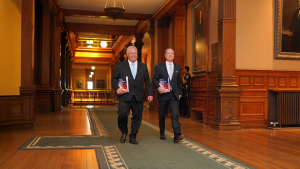The Toronto buildings featured in this year’s Building Storeys photography exhibit tell stories of not just architectural beauty but also of the hard work by construction workers who built them.
The Toronto buildings featured in this year’s Building Storeys photography exhibit tell stories of not just architectural beauty but also of the hard work by construction workers who built them.
“The photos are great and we want our members and contractors to know about them as in many cases they have worked on the sites depicted,” said Mike Yorke of the Carpenters’ District Council of Ontario.
Building Storeys is a collaborative effort by Heritage Toronto and a group of Toronto architectural photographers which aims to document Toronto’s architectural history both unseen and forgotten.
The carpenters union is the “builder supporter” for the exhibit currently showcased on two floors of The Gladstone Hotel which has extended its run until April 25.
“We thought that industrial buildings would be something that people do not often think about as things of beauty,” said Peggy Mooney, executive director at Heritage Toronto.
“When in fact there are a lot of public buildings built even a hundred years ago in which great care was taken in their design and building of them.”
Among the featured locations in the exhibit are the R.L. Hearn Generating Station, the John Street Roundhouse, R.L. Clark Water Treatment Plant, R.C. Harris Water Filtration Plant and Canada Linseed Oil Mills.
Mooney recalled at the launch of the exhibit, members of the carpenters’ union proudly talked about how they helped build some of the iconic industrial buildings photographed for Building Storeys.
Photographer Olena Sullivan had photos showcased in the exhibit and helped coordinate its various photo shoots.
She said the skill and craftsmanship of the designers and builders of the buildings can still be appreciated today.
“When most people think of industrial, they think it is grimy and dirty and we wanted to show it really is not that way,” explained Sullivan.
“We focused on buildings from the early 1900s to the 1950s; they were built not just for function but also architecturally beautiful.
“Though some of them sit empty now, they are still solid buildings.”
Visit www.buildingstoreys.com for more information.










Recent Comments
comments for this post are closed